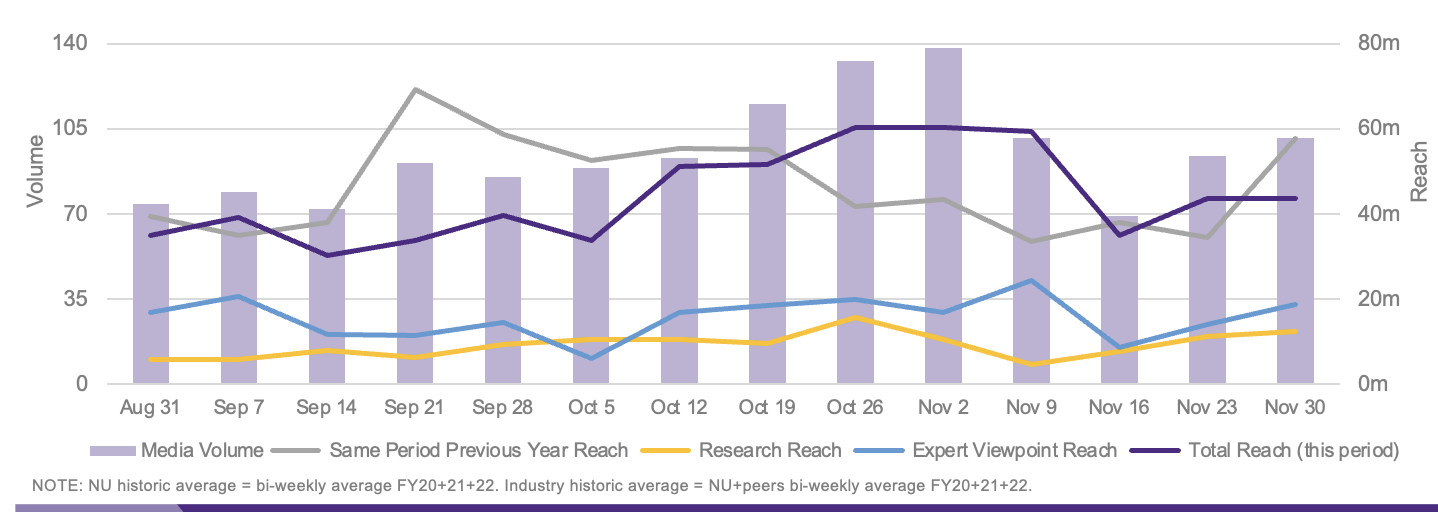Your colleagues in the newsCheck out the top-reaching stories of academic impact in traditional media. Metrics draw from English-language print, broadcast and online global media outlets. | Top stories (November 27-December 4) |
- Emily Rogalski and Tamar Gefen find that "SuperAgers" — people age 80 or over with exceptionally good memories — may have larger than expected neurons in a region of the brain that is critical for memory. To date, the study has been cited in 350 stories for a reach of 17.4 million. Top outlets include CNN and news broadcasts.
- Following public antisemitic comments by prominent figures, Peter Hayes discusses the debate Jews have historically faced about how best to respond — or not — to the behavior. Hayes has been cited in 15 stories for a reach of 6.3 million. Top outlets include The New York Times and the Chicago Tribune.
- Alexander Chernev discusses the distinctions between Black Friday in the U.S. and Singles' Day in China and how sales compare. Chernev has been cited in 47 stories for a reach of 4.5 million. Top outlets include Reuters, the International Business Times and the Daily Mail.
*To allow time for data processing and validation, the reporting period for top stories and quantitative media metrics runs Thursday-Wednesday. |  |
| In the Spotlight | Read in-depth coverage of Northwestern faculty work and research. |  From U.S. News & World Report A new study finds that teenagers and young adults who use benzodiazepines to treat insomnia may be at heightened risk of overdose. Researchers found that young people prescribed those medications for insomnia were at increased risk of overdose within the next six months. Feinberg’s Dr. Sabra Abbott tells U.S. News we don't have to treat insomnia with benzodiazepines or necessarily use medication at all. Instead, Abbott suggests young people can establish healthier sleep patterns by changing their waking habits — including reducing caffeine and screen time in the evening. |  From CNN Early studies point to a promising application of artificial intelligence to determine, from a single chest X-ray, the risk of a patient dying from a heart attack or stroke in the next 10 years. Feinberg’s Dr. Donald Lloyd-Jones, who was not involved in the study, says the findings are promising for early intervention efforts, suggesting doctors can then work with higher-risk patients to, for example, find ways to stop smoking. |  From ABC Chicago As the Senate approved partisan legislation to uphold same-sex unions, Northwestern Law’s Andrew Koppelman spoke with ABC Chicago about options available to same-sex couples looking to wed. If same-sex marriage is not allowed in a couple's home state, Koppelman notes they could get married and file the marriage license in another state instead; their home state will then have to recognize the union. |
| NU Voices | Read perspectives from Northwestern faculty in national media. |  From Sterling Elliott, Chicago Tribune “Despite years of devastation that have broken families and communities apart, Congress has yet to take action to expand access to safe, federally approved methods to manage pain. … Federal policy lags behind, which is why Congress should pass legislation with urgency to ensure patients and their providers have choices in pain management,” Sterling Elliott writes in the Chicago Tribune. |
| Media metrics | The following metrics reflect Northwestern's performance in 75 priority media outlets, chosen based on their reach and influence with key academic audiences. | Priority Media Outlet Performance Metrics | Coverage over time: |  |
| Northwestern topic breakdown: |  | | *Topic areas are assigned based on keyword search and reflect the subject of the article, not the department or unit of the individual cited. Some articles may be counted under multiple topic areas. |
|
| About | This weekly newsletter serves as a resource for faculty and communications staff, sharing news opportunities and highlighting faculty and University successes in traditional media. It also provides communications tools such as media training resources and announcements about upcoming sessions.
By providing these resources, we hope to help faculty show their expertise to a national and international audience as well as recognize those who are making an impact.
We welcome your feedback on this and all of our communications tools. You can reach us any time at media@northwestern.edu.
Subscribe to Northwestern in the Media. |
|
|






